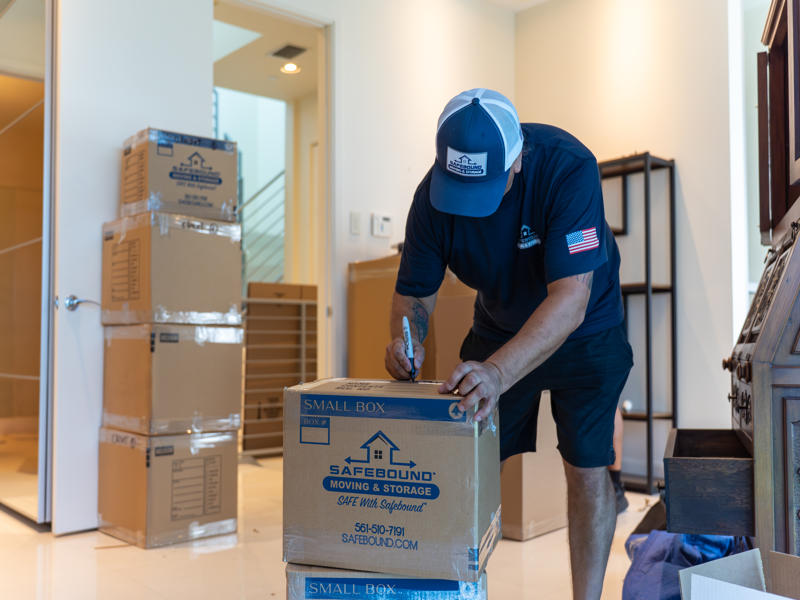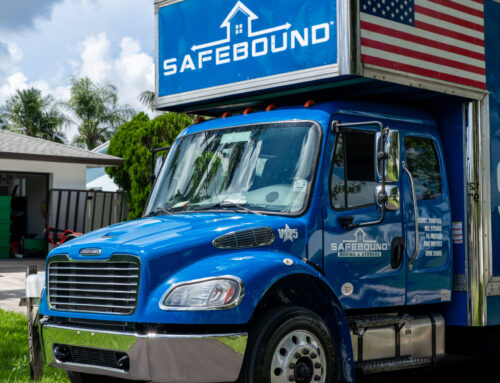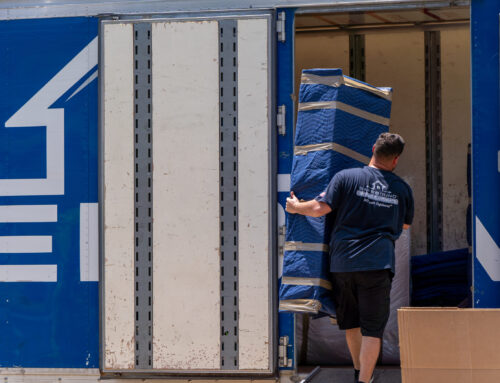Eco-friendly moving tips can transform your relocation into an environmentally responsible experience. Moving into a new home marks the start of an exciting chapter — but it can also create a surprising amount of waste. Between stacks of cardboard boxes, disposable packing materials, and fuel-hungry trucks, even a small move can leave a big environmental footprint.
At Safebound Moving, we believe there’s a better way. With a little planning, you can cut down on waste, save energy, and make your move greener without adding extra stress. Here’s how to plan an eco-friendly move that’s both efficient and sustainable using these proven eco-friendly moving tips.
1. Start with a Smart Declutter
When implementing eco-friendly moving tips, decluttering is your first step. Before you start packing, go through your home and separate what you truly need from what you can sell, donate, or recycle. The fewer items you move, the fewer boxes, packing supplies, and trips you’ll need — which means less fuel and fewer emissions.
- Donate gently used items to local organizations or thrift stores.
- Host a yard sale or use resale apps to give your belongings a second life.
- Recycle electronics and hazardous materials properly instead of tossing them.
Not only does decluttering reduce waste, but it also cuts down on your moving costs and setup time at your new place. Think of it as a financial and environmental win-win. Studies show that the average American household contains around 300,000 items, and most of us use only about 20% of what we own regularly. Moving is the perfect time to reassess what truly adds value to your life and let go of the rest responsibly.
For electronics recycling, check EPA’s electronics recycling guidelines to find certified e-waste recyclers in your area.
2. Reuse Boxes and Packing Materials
One of the best eco-friendly moving tips is to reuse packing materials. Instead of buying new boxes, ask local grocery stores, liquor shops, or bookstores if they have extras to give away. You can also find gently used moving boxes through online marketplaces or community groups. Many people are eager to pass along their moving supplies after they’ve settled in, creating a circular economy that benefits everyone.
And don’t forget about what you already own:
- Suitcases, laundry baskets, and bins can double as storage containers.
- Old towels, blankets, and clothing can protect fragile items.
- Reusable bags are perfect for smaller odds and ends.
This creative approach not only saves money but also ensures that items you’re already transporting serve a dual purpose during the move.
3. Choose Eco-Friendly Packing Supplies
Among the most impactful eco-friendly moving tips is choosing sustainable packing materials. If you need to buy new packing materials, choose eco-conscious options:
- Recycled cardboard boxes and biodegradable packing peanuts are better alternatives to plastic.
- Paper tape instead of traditional plastic tape helps reduce plastic waste and makes boxes easier to recycle.
- Corrugated bubble wrap or mushroom-based packaging are innovative, compostable solutions that offer excellent protection.
You can also look for packing material recycling centers near your new neighborhood to drop off any leftovers after your move. Many shipping stores will happily accept used packing peanuts and bubble wrap for reuse, keeping these materials in circulation rather than sending them to landfills.
Learn more about sustainable packing alternatives from environmental experts.
4. Optimize Your Travel Plan
These eco-friendly moving tips for travel optimization can significantly reduce your carbon footprint. One of the easiest ways to make your move greener is to simply minimize fuel use. Transportation accounts for a significant portion of a move’s carbon footprint, so strategic planning makes a real difference. Try to:
- Plan the most efficient route between your old and new homes using GPS tools that account for real-time traffic.
- Consolidate trips so you aren’t making multiple small hauls — one well-packed truck beats several partially filled vehicles.
- Schedule your move during off-peak hours to avoid heavy traffic, which wastes fuel through idling and stop-and-go driving.
Working with experienced movers can help you plan your route and optimize your load to save both time and energy. If you’re interested in understanding the broader impact, read about the environmental impact of moving.
5. Clean Without the Chemicals
Eco-friendly moving tips extend to cleaning as well. Moving means cleaning — sometimes twice. When scrubbing your old or new home, use eco-friendly cleaning products that are biodegradable and non-toxic.
You can even make your own natural cleaners with simple ingredients like vinegar, baking soda, and lemon juice. They’re safe for pets, kids, and the planet — and they work just as well as store-bought options. A basic mixture of equal parts white vinegar and water tackles most surfaces beautifully, while baking soda provides gentle abrasive power for tougher jobs.
Avoid single-use paper towels by using reusable microfiber cloths, which are more durable and generate less waste. A set of quality cleaning cloths can last for years and be washed hundreds of times, eliminating the need for rolls upon rolls of disposable paper products.
For more natural cleaning recipes, visit EPA’s Safer Choice program.
6. Recycle and Dispose Responsibly
Once you’re settled in, resist the urge to toss leftover boxes and materials in the trash. Instead:
- Flatten and recycle cardboard boxes according to your local recycling guidelines.
- Save bubble wrap and paper for future shipping needs or offer them to friends who might be moving soon.
- Drop off used packing peanuts at local mail or shipping stores for reuse.
If you’re upgrading furniture or appliances, look into local recycling programs that handle bulky or electronic items responsibly. Many communities offer pickup services for large recyclables. Electronics contain valuable materials that can be recovered and reused, so proper e-waste recycling is essential for reducing environmental impact.
Find recycling resources through Earth911’s recycling search tool.
7. Support Sustainable Brands
As you settle into your new home, consider how you can continue your eco-conscious habits:
- Purchase energy-efficient appliances and LED lighting to reduce your long-term energy consumption.
- Choose sustainable furniture made from reclaimed or responsibly sourced wood.
- Look for local, eco-friendly services — from cleaning to landscaping — to support your green lifestyle long-term.
Every choice adds up. A greener move is just the beginning of a more sustainable way to live. Energy Star-rated appliances can reduce your utility bills by 10-50% while significantly cutting your carbon footprint, making them an investment that pays dividends both financially and environmentally.
Check out Energy Star’s product finder to identify the most efficient appliances for your new home.
8. Donate What You Can’t Take
These eco-friendly moving tips include responsible disposal. Sometimes you simply can’t move everything. Instead of adding to landfill waste:
- Donate furniture and household items to Habitat for Humanity ReStore, Goodwill, or local shelters.
- Offer leftover packing materials through neighborhood apps or community boards like Nextdoor or Buy Nothing groups.
- Consider coordinating donation drop-offs during your move day to maximize efficiency.
Many organizations will gladly accept gently used furniture, giving it a second life and helping those in need.
9. Keep Sustainability Going After the Move
The best eco-friendly moving tips continue long after moving day. Once you’re settled, keep your eco-friendly mindset going:
- Set up recycling stations early so it becomes a daily habit for everyone in your household.
- Plant native greenery around your new home to support local ecosystems and reduce water consumption.
- Switch to paperless billing and digital records to reduce waste.
These small, ongoing choices make your eco-friendly move more than just a one-time effort — they help build a long-term sustainable lifestyle. Consider conducting an energy audit of your new home to identify opportunities for improved efficiency, such as adding insulation, sealing air leaks, or installing a programmable thermostat.
Making Green Moves with Safebound
Choosing to move sustainably doesn’t mean sacrificing convenience. With Safebound Moving, you can have both — a stress-free, efficient move and a lighter footprint on the planet.
Our professional movers are trained to pack efficiently and handle your belongings with care. We understand that every move is unique, and we’re committed to providing exceptional service that makes your relocation as smooth as possible. Whether you’re moving locally or long-distance, Safebound is here to help you get where you need to go.
Ready to Make Your Move Greener?
Implementing these eco-friendly moving tips is easier than you think. Every move is an opportunity to make better choices — for your home, your family, and the environment. Start small, think sustainably, and let professionals who care handle the rest.
The environmental benefits of an eco-friendly move extend far beyond moving day. By choosing sustainable practices now and following these eco-friendly moving tips, you’re setting the tone for how you’ll live in your new space. You’re also contributing to a larger movement toward responsible consumption and waste reduction that benefits your entire community.
Get your free quote today and book your move with Safebound Moving — where quality service meets reliability.




